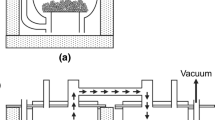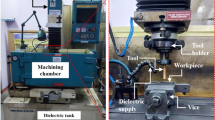Abstract
In recent years, countries around the world are researching the use of hydrogen in the field of metallurgy to reduce carbon emission. However, the application of hydrogen is limited in ironmaking and the production of nonferrous metals, which is lack in steelmaking. The insufficiency of temperature and “slag dilution” phenomenon severely restrict the high manganese stainless steel smelting in conventional process. Based on the analysis of these two problems, this paper proposes a new method of stainless steel smelting by hydrogen blowing. By the theoretical calculation, the feasibility and advantages of hydrogen blowing in high manganese stainless steel smelting are analyzed. In the first decarbonization period, the temperature of molten steel can be increased more quickly by 188 K in 20 min, reducing 1.4 t carbon emissions at the same time, or additional 7.8–9.3 t of cold charge can be added by blowing hydrogen from the side gas jet. And the activity of chromium VI in the slag can be reduced to 10–20 effectively by blowing hydrogen. In the second decarbonization period, hydrogen blowing can also control the content of dissolved oxygen in molten steel and reduce the oxidation of chromium, manganese and iron, which may succeed in inhibiting “slag dilution” phenomenon. In the reduction period, the use of hydrogen to replace argon as the stirring gas can promote the reduction of chromium oxide, manganese oxide and iron oxide in the slag and increase the final metal yield.
Graphical Abstract
The advantages of hydrogen blowing in steelmaking












Similar content being viewed by others
Data Availability
The data that support the findings of this study are available from the corresponding author upon reasonable request.
References
Abdul QM, Ahmed S, Dawal SZ, Nukman Y (2016) Present needs, recent progress and future trends of energy-efficient ultra-low carbon dioxide (CO2) Steelmaking (ULCOS) program. Renew Sustain Energy Rev 55:537–549. https://doi.org/10.1016/j.rser.2015.10.101
Bale CW, Bélisle E, Chartrand P, Decterov SA, Eriksson G, Gheribi AE, Hack Jung IH, Kang YB, Melançon J, Pelton AD, Petersen S, Robelin C, Sangster J, Spencere P, Van EMA (2016) FactSage thermochemical software and databases, 2010–2016. Calphad 54:35–53. https://doi.org/10.1016/j.calphad.2016.05.002
Chen YB, Zou HB (2021) Review of hydrogen-rich ironmaking technology in blast furnace. Ironmaking Steelmaking 48:749–768. https://doi.org/10.1080/03019233.2021.1909992
He QQ (2021) Progress of HYBRIT fossil free smelting technology in Swedish iron and steel industry. Metall Econ Manage 1:52–56. https://doi.org/10.3969/j.issn.1002-1779.2021.01.016
Hu JG, Zhou WT, Dong G (2015) Current situatoin of R & D on COURSE 50 technology in Japan. ANGANG Technology. 391:8–12. https://doi.org/10.3969/j.issn.1006-4613.2015.01.002
Hu JG, Guo YL, Zhou WT, Yang M (2011) Analysis of the progress and application prospects of new low-carbon ironmaking technology in the United States. Metall Manage. 2:51–53. http://www.cnki.com.cn/Article/CJFDTotal-YJGL201102012.htm.
Huang H (2019) Exploration of metallurgical engineering technology based on low-carbon economy. Sci Technol Innov Herald. 16:51–52. https://doi.org/10.16660/j.cnki.1674-098X.2019.25.051
Li W, Fu GQ, Chu MS, Zhu MY (2020a) An effective and cleaner process to recovery iron, titanium, vanadium, and chromium from Hongge vanadium titanomagnetite with hydrogen-rich gases. Ironmaking Steelmaking 48:33–39. https://doi.org/10.1080/03019233.2020.1721955
Li GX, Cui PZ, Wang YL, Liu ZQ, Zhu ZY, Yang S (2020b) Life cycle energy consumption and GHG emissions of biomass-to-hydrogen process in comparison with coal-to-hydrogen process. Energy 191:116588. https://doi.org/10.1016/j.energy.2019.116588
Liu J, Liu SJ, Ju SG, Du WG, Pan F, Yang S (2013) The effect of sodium sulphate on the hydrogen reduction process of nickel laterite ore. Miner Eng 49:154–156. https://doi.org/10.1016/j.mineng.2013.05.023
Liu HB, Liu JH, Schenk J, Florian MP, Sun L, Zhang RZ, An ZG (2020) Effect of CO2 and O2 mixed injection on the decarburization and manganese retention in high-Mn twinning-induced plasticity steels. Metall and Mater Trans B 51B:756–762. https://doi.org/10.1007/s11663-020-01776-1
Luo Y, Wang C (2017) In: Energy Saving and Emission Reduction Measures of Korean Steel Companies: the 11th China Steel Annual Meeting, p. 6.
Ma SF, Li KJ, Zhang JL, Jia CH, Bi ZS, Sun MM, Wang ZM (2021) Effect of MnO content on slag structure and properties under different basicity conditions: A molecular dynamics study. J Mol Liq 366:116304. https://doi.org/10.1016/j.molliq.2021.116304
Ren L, Zhou S, Ou XM (2023) The carbon reduction potential of hydrogen in the low carbon transition of the iron and steel industry: The case of China. Renew Sustain Energy Rev 171:113026. https://doi.org/10.1016/j.rser.2022.113026
Sam (2020) The role of zero and low carbon hydrogen in enabling the energy transition and the path to net zero greenhouse gas emissions : with global policies and demonstration projects hydrogen can play a role in a net zero future. Johnson Matthey Technol Rev 64:357–370. https://doi.org/10.1595/205651320X15910225395383
Sebastian T, Martin K, Matthias F (2020) Hydrogen and hydrogen-derived fuels through methane decomposition of natural gas – GHG emissions and costs. Energy Conver Manage X 7:100043. https://doi.org/10.1016/j.ecmx.2020.100043
Su YJ, Du YH, Chen SL (2009) Technique and estimation of using reducing gas from iron ore-coal briquette to produce direct reduced iron. J Univ Sci Technol Beijing 31(1):43–48. https://doi.org/10.13374/j.issn1001-053x.2009.s1.033
Tang J, Chu MS, Li F, Feng C, Liu ZG, Zhou YS (2020) Development and progress on hydrogen metallurgy. Int J Miner Metall Mater 27(6):713–723. https://doi.org/10.1007/s12613-020-2021-4
Wei JH, Zhu DP (2002) Mathematical modeling of the argon-oxygen decarburization refining process of stainless steel: Part I. Mathematical model of the process. Metall and Mater Trans B 33:111–119. https://doi.org/10.1007/s11663-002-0091-5
Yao Xi, Guo HJ (2014) Research on the smelting process of carboxyhemoglobin concentration plot. 2014 National Conference on Physical Chemistry of Metallurgy. Baotou, China
Xu H, He Y, Liu JH, Xie MY, Huang GY (2022) Application of CO2 and O2 mixed blowing on the decarburization and manganese retention. ISIJ Int 62(4):669–676. https://doi.org/10.2355/isijinternational.ISIJINT-2021-520
Yan JJ (2017) Progress and future of ultra-low carbon dioxide steelmaking projects. China Metall. 27:6–11. https://doi.org/10.13228/j.boyuan.issn1006-9356.20160169
Zhang JY (2004) Physical Chemistry of Metallurgy. Metallurgical Industry Press, Beijing
Zhang Y, Jiao SQ, Chou KC, Zhang GH (2020a) Size-controlled synthesis of Mo powders via hydrogen reduction of MoO2 powders with the assistance of Mo nuclei––ScienceDirect. Int J Hydrogen Energy 45(3):1435–1443. https://doi.org/10.1016/j.ijhydene.2019.11.008
Zhang J, Liu JH, Yu SJ, Su XF, He Y (2020b) Bubble growth and floating behavior during degassing process of molten steel/(N2, H2) system. ISIJ Int 60(3):470–480. https://doi.org/10.2355/isijinternational.ISIJINT-2018-875
Zhang XY, Jiao KX, Zhang JL, Guo ZY (2021) A review on low carbon emissions projects of steel industry in the World. J Clean Prod 306:127259. https://doi.org/10.1016/j.jclepro.2021.127259
Zhang YJ, Yue Q, Chai XC, Wang Q, Lu YQ, Ji W (2022) Analysis of process parameters on energy utilization and environmental impact of hydrogen metallurgy. J Clean Prod 361:132289. https://doi.org/10.1016/j.jclepro.2022.132289
Zhao YH, Li XH (2017) Improvement of top gas dust removal system of Xinjiang Bayi iron & steel Ouye furnace. Bao Steel Technol 3:74–78. https://doi.org/10.3969/j.issn.1008-0716.2017.03.016
Zhu HB, Tang DQ, Li YL, Yang X, He W (2015) Refining mechanisms of arsenic in the hydrogen reduction process of tungsten oxide. Adv Powder Technol 26(3):1013–1020. https://doi.org/10.1016/j.apt.2015.04.007
Acknowledgements
The authors gratefully acknowledge the financial support of this research by the National Natural Science Foundation of China (Grant No. 51874028), the Central Guidance on Local Science and Technology Development Fund of Hebei Province (Grant No. 216Z1009G) and the Natural Science Foundation of Hebei Province (Grant No. E2021318004).
Author information
Authors and Affiliations
Contributions
All authors contributed to the study conception and design. Data collection and analysis were performed by Hao Xu. All authors cooperated to prepare each version of the manuscript. All authors read and approved the final manuscript.
Corresponding author
Ethics declarations
Competing Interests
The authors have no relevant financial or non-financial interests to disclose.
Additional information
Publisher's Note
Springer Nature remains neutral with regard to jurisdictional claims in published maps and institutional affiliations.
Rights and permissions
Springer Nature or its licensor (e.g. a society or other partner) holds exclusive rights to this article under a publishing agreement with the author(s) or other rightsholder(s); author self-archiving of the accepted manuscript version of this article is solely governed by the terms of such publishing agreement and applicable law.
About this article
Cite this article
Xu, H., Liu, J., He, Y. et al. Performance analysis of hydrogen blowing in high manganese stainless steel smelting. Clean Techn Environ Policy 25, 2377–2391 (2023). https://doi.org/10.1007/s10098-023-02518-y
Received:
Accepted:
Published:
Issue Date:
DOI: https://doi.org/10.1007/s10098-023-02518-y




